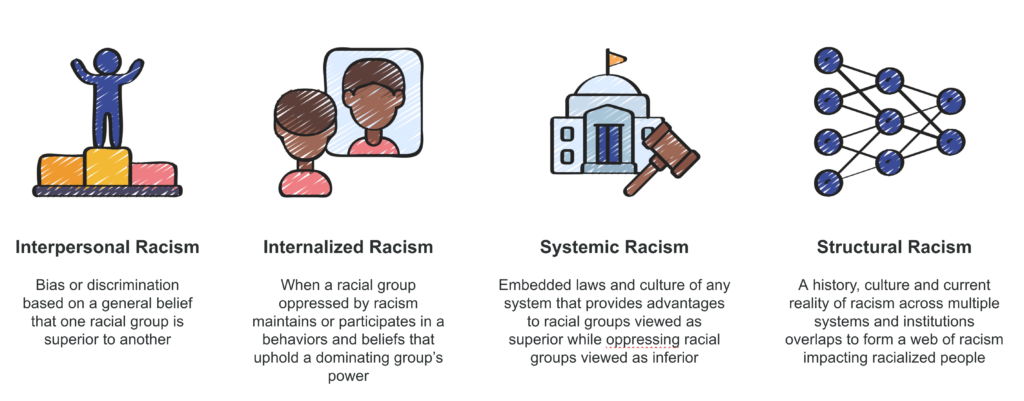During Black Futures Month, many organizations ask what they can do to cultivate safer workplaces for Black employees. Before identifying specific tools, we must understand anti-Black racism within broader systems, of which workplaces are only part.
“Anti-Black racism has long been embedded in Canadian communities, and institutions (workplaces being one of them). While good intentions are often behind the call for immediate solutions and actions to changing that reality, it’s equally as important to spend time listening and learning. Understanding the historical context of anti-Black racism – and the broader context of how it continues to show up today – ensures that actions are both thoughtfully informed and work in tandem with the on-going efforts of Black folks.
– Shalyma Cambridge, Partner, Inclusivity
Anti-Black Racism
Anti-Black racism is unique, rooted in the history and experience of enslavement. It targets all people of African descent. It uses myths and stereotypes related to biology, intelligence, morality, and more to justify discrimination.
This racism is built into society in many ways, across scales:

Anti-Black racism is embedded in Canadian institutions, policies and practices, affecting education, employment and wealth, the justice system, and healthcare.
For example, 46 percent of Black people aged 15 and over reported experiencing at least one form of discrimination over the last five years when dealing with police. In another example, only 1.8 percent of Canadian elementary school teachers were Black, while there is overwhelming evidence that the success of Black students is supported by having Black teachers.
Anti-Black Racism in the Workplace
Studies have shown that Black Canadians continue to face overt and covert interpersonal racism in the workplace, affecting fairness of hiring processes, recognition of competence, acknowledgement for achievements, access to opportunities for mentorship or career advancement, and job stability. For example:
- The hiring process can be full of bias and exclusion. One study in Quebec indicated that applicants with Franco-Quebecois names were called for an interview 38.3% more often than those with African names.
- More Black people are overqualified for their jobs, with an overqualification rate of 16 percent, compared to the national average of 11.1 percent.
- At work, Black employees often find themselves with Black colleagues and may face additional demands and burdens that result from being “the face of the race.”
These barriers and daily challenges can result in feelings of exclusion and pose significant challenges for Black employees’ morale.
Workplace Tools
There are several types of tools for creating safer, more inclusive workplaces for Black employees. These tools are organized at three levels – in organizations, in relationships, and within individuals – but are of course overlapping and interconnected.
Organizational Tools
- Modify the recruitment and hiring process, such as by using community connections, having diverse interview panels, and taking steps to mitigate bias.
- Increase learning and development, such as by spending training dollars on intercultural competence.
- Using data to uncover what is hidden; it is important to know the numbers, set goals, and be transparent about progress.
- Update policies and practices across the organization, using clear anti-racist language, and articulating and applying consequences.
- Support mental health, including access to Black counselors and other supports (e.g. coaches, psychologists).
Relationship Tools
- Build community connections, including through outreach (e.g. co-ops and internships, community partnerships) and consistent engagement with Black communities and services.
- Create spaces to connect, learn about each other, and celebrate what is important. Mentorships and employee resource groups can be impactful. Partnerships with other organizations can help if resources are low.
Individual Tools
- Make it personal, within homes, families and communities. Build awareness and “cultural intelligence” around current events.
- Challenge yourself to maintain curiosity, humility, and courage. It is also important to be consistent; commitment is key.
The Effects of Addressing Anti-Black Racism in the Workplace
Addressing anti-Black racism will have a positive effect on the company or organization, creating a more inclusive and welcoming space for all. A workplace that is safe and welcoming will also see reputational gains – resulting in a more diverse pool of prospective employees and an expansion of the customer/client base.
The net result is overall societal gain. If organizations take a proactive approach to addressing anti-Black racism, there are countless positive impacts to not only Black community members but to the overall Canadian society.
When an organization addresses anti-Black racism all Canadians benefit through economic advancement, business development, entrepreneurship, homeownership, improved health and educational opportunities, and more diverse culture and cultural representation.
Inclusivity Webinar: “Black Futures Month: Cultivating Safer Workplaces for Black Employees”
On February 8, 2023 Inclusivity hosted a webinar on Black Futures Month on how companies and organizations can help create better, safer, more inclusive workplaces for Black workforces.
Webinar Participants’ Experiences with Anti-Black Racism
Throughout the webinar, participants described their own experience with anti-Black racism. Their willingness to share supported learning in the webinar, and we gratefully acknowledge their contributions.
- The chat was filled with participants’ experiences of anti-Black racism across institutions.
- Participants described the lack of Black teachers and support staff in schools, and the experience of being discriminated against throughout their school years.
- They told of police being called on young Black children.
- They described experiencing blatant racism from medical care providers.
- Participants also identified the problem of a lack of data on race-based discrimination. Without this data, deep-rooted problems are often met with dismissive responses, participants said.
- Participants also shared the overall fatigue that arises from racial trauma, and how this fatigue saps the will to fight back, share the facts, and demand change.
Overall, participants’ experiences demonstrate clearly the ongoing anti-Black racism in Canada and the need for more data and anti-racist efforts across institutions.
This article is based on the “Black Futures Month: Cultivating Safer Workplaces for Black Employees” presentation delivered on February 2023 by Shalyma Cambridge Facilitator, Inclusivity. To host a webinar on this topic in your organization, or community, please contact [email protected]
Additional Resources
Continue your learning…
News Media: Various media produced by CBC providing a window into the celebration and struggles of the diverse Black communities in Canada.
Social Media: Canada’s number one Black online magazine featuring self-identified Black Canadian writers covering topics ranging from new Black Canadian entrepreneurs, Black Canadian business profiles, Black Canadian history, and profiles on Black Canadian artists.
History of Black Communities in Canada
History: A list of organizations and educational resources across the country devoted to the promotion and awareness of the history of Black communities in Canada. Below you can find some organizations and insightful resources.
Black Canadian Content Creators aka #BCANCC
Podcast: A podcast showcasing digital or analog content creators (bloggers, podcasters, directors, videographers, photographers, authors, writers, vloggers, youtubers, influencers, musicians, artists and more) who identify as Black, African, Caribbean or Mixed in Canada or Black Canadians living and creating abroad.
Books: A physical and online bookstore with a vast compilation of literary gems from Canada’s cultural mosaic including Black authors and subject matter connected to North America, Africa, the Caribbean, Asia, South America.
Connect with a Black-led Charity (with Canada-wide operations:)
Federation of Black Canadians (A national organization that advances Black Canadians’ social, economic, political and cultural interests).
The Black Opportunity Fund (a community-led registered Canadian Charitable organization, that supports a prosperous, healthy and thriving Black Canada by challenging anti-Black racism in responding to long standing underinvestment in Black communities and working nationally to strengthen collective actions by Black organizations and leaders).
Black Boys Code & Black Kids Code (Provides computer science education and digital literacy to Black kids through educational workshops).
Black Youth Helpline (Serves all youth and specifically responds to the need for a Black youth specific service, positioned and resourced to promote access to professional, culturally appropriate support for youth, families and schools).
Black Health Alliance (A community-led registered charity working to improve the health and well-being of Black communities in Canada).– Black Business and Professional Association (A non-profit, charitable organization founded in 1983 that addresses equity and opportunity for the Black community in business, employment, education and economic development).
Canadian Black Chamber of Commerce (a cultural non-profit organization created to generate commerce for Black-owned businesses and entrepreneurs and support economic development within Black communities across Canada).
Sources:
Robert D. Austin and Gary P. Pisano. 2017. Neurodiversity as a Competitive Advantage. Harvard Business Review. https://hbr.org/2017/05/neurodiversity-as-a-competitive-advantage
Deloitte. n.d. Embracing Neurodiversity at Work: How Canadians With Autism Can Help Help Employers Close the Talent Gap. https://www2.deloitte.com/content/dam/Deloitte/ca/Documents/fcc/ca-canada-2030-policy-brief-aoda-en.pdf?icid=untapped-fcc-latest-en
Mary Theresa Bitti, 2022. How Neurodiverse Perspectives Can Help Fuel Innovation. May 16, 2022. FInancial Post.
Bernard Grant, 2022. What Does a Neuro-Divergent Inclusive Workplace Look Like?” Best Colleges. https://www.bestcolleges.com/careers/neurodivergent-inclusive-workplace/
Victoria McQueen, 2022. EY Expands Neurodiversity Centres of Excellence in Canada. EY Canada. https://www.ey.com/en_ca/news/2022/09/ey-expands-neurodiversity-centres-of-excellence-in-canada
National Bank, 2022. National Bank Works with EY Canada to Support Neurodiversity in the Workplace. https://www.nbc.ca/about-us/news-media/press-release/2022/20220401-La-BNC-et-EY-font-la-promotion-de-la-neurodiversite.html
Alisha S. Richmond. 2022. About Us: Specialisterne. https://ca.specialisterne.com/aboutus/






















